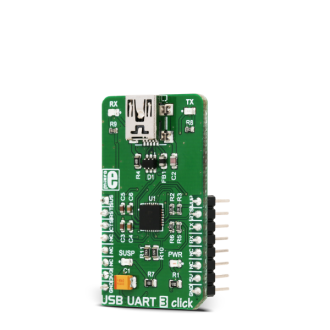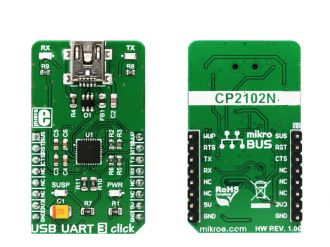
We strongly encourage users to use Package manager for sharing their code on Libstock website, because it boosts your efficiency and leaves the end user with no room for error. [more info]

Rating:
Author: MIKROE
Last Updated: 2018-06-27
Package Version: 1.0.0.0
mikroSDK Library: 1.0.0.0
Category: USB
Downloaded: 5328 times
Not followed.
License: MIT license
USB UART 3 click is a versatile and feature-rich USB to UART interface from Silicon Labs. It uses CP2102N which is a part of their USBXpress family. These devices are designed to quickly add a USB 2.0 full-speed compliant UART interface for custom applications.
Do you want to subscribe in order to receive notifications regarding "USB UART 3 click" changes.
Do you want to unsubscribe in order to stop receiving notifications regarding "USB UART 3 click" changes.
Do you want to report abuse regarding "USB UART 3 click".


Library Description
Library performs IR and temperature measurement. The sensor gets an IR picture of the detected object (body) and measures ambient temperature, compares that two measurements and shows the IR picture as a 16x4 matrix. For more details check the documentation.
Key functions:
void usbuart3_writeByte(uint8_t input) - Write Single Byte.uint8_t usbuart3_readByte() - Read Single Byte.uint8_t usbuart3_byteReady() - Check for the new byte received.Example description
The application is composed of three sections:
void applicationTask()
{
char tmp;
uint8_t rdyFlag;
// RECEIVER - UART polling
rdyFlag = usbuart3_byteReady();
if (1 == rdyFlag)
{
tmp = usbuart3_readByte();
mikrobus_logWrite( &tmp, _LOG_BYTE );
}
// TRANSMITER - TX each 2 sec
for (tmp = 0; tmp < 9; tmp++)
{
usbuart3_writeByte( MESSAGE_DATA[tmp] );
mikrobus_logWrite( "MESSAGE SENT", _LOG_LINE );
}
Delay_ms(2000);
}
Other MikroElektronika libraries used in the example:
Additional notes and information
Depending on the development board you are using, you may need USB UART click, USB UART 2 click or RS232 click to connect to your PC, for development systems with no UART to USB interface available on the board. The terminal available in all MikroElektronika compilers, or any other terminal application of your choice, can be used to read the message.